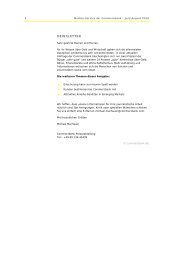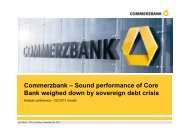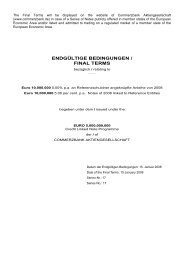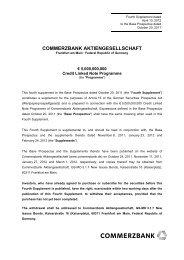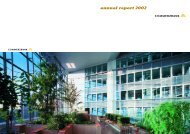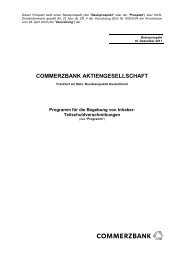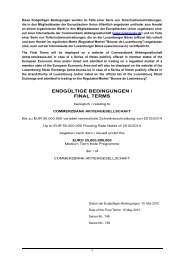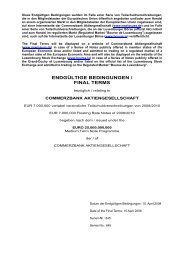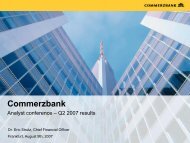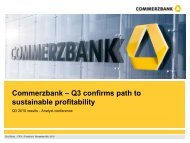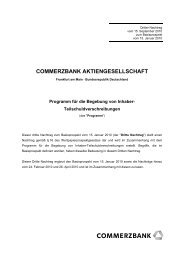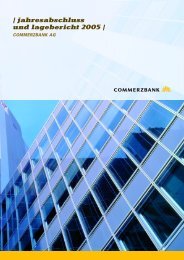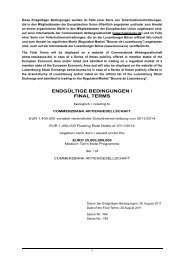COMMERZBANK AKTIENGESELLSCHAFT
COMMERZBANK AKTIENGESELLSCHAFT
COMMERZBANK AKTIENGESELLSCHAFT
Create successful ePaper yourself
Turn your PDF publications into a flip-book with our unique Google optimized e-Paper software.
To our Shareholders Interim Management Report Interim Financial Statements<br />
Risk Report<br />
231 Business and economy<br />
232 Earnings performance, assets and financial position<br />
237 Forecast<br />
240 Report on post-balance sheet date events<br />
241 Risk Report<br />
I. Risk-oriented overall bank management<br />
1. Risk management organization<br />
The financial market crisis once again demonstrated that<br />
the professional limitation and management of banking<br />
risks are critical factors in our business success. Essential<br />
prerequisites for successful risk management are the identification<br />
of all significant risks and risk drivers, the independent<br />
measurement and assessment of these risks in<br />
an evolving macroeconomic environment with changing<br />
portfolio-specific conditions, and the risk /return-oriented<br />
management of risks based on these assessments as part of<br />
a forward-looking risk strategy. We made considerable progress<br />
in this area in the past few years which should pay off<br />
in the dramatically deteriorating environment.<br />
Commerzbank defines risk as the danger of possible<br />
losses or lost profits due to internal or external factors. Risk<br />
management distinguishes between quantifiable risks – those<br />
for which a value can normally be given in annual financial<br />
statements or in regulatory capital requirements – and nonquantifiable<br />
risks such as reputational and compliance<br />
risks.<br />
For a more detailed explanation of Commerzbank’s risk<br />
management organization please refer to our 2008 Annual<br />
Report which provides in the summary outlook an overview<br />
of the restructuring of the risk function which is being<br />
implemented as part of the risk integration project.<br />
2. Risk-taking capability<br />
Risk-taking capability is monitored by comparing the<br />
Commerzbank Group’s aggregate capital requirement with<br />
the Tier 1 core capital available to cover risk. We analyse the<br />
Group’s capital requirement in both the regulatory and economic<br />
capital model. In addition to calculating regulatory<br />
capital requirements in the form of risk-weighted assets<br />
(RWA), since the start of 2009 economic RWA have been<br />
determined using internal risk models with a confidence<br />
level of 99.95 % and a holding period of one year. In order<br />
to ensure the greatest possible transparency and comparability,<br />
the capital available is determined uniformly using<br />
the legally defined Tier 1 core capital.<br />
By converting the economic capital requirement into<br />
RWA equivalents, a direct comparison with the regulatory<br />
view is possible and can be shown appropriately in the form<br />
of capital ratios. As of the reporting date Commerzbank’s<br />
regulatory risk-weighted assets were €297bn. This corresponds<br />
to a regulatory core capital ratio of 11.3 %. The economic<br />
risk-weighted assets for default, market, operational<br />
and business risk computed using internal models were<br />
€255bn (economic core capital ratio of 13.1 %).<br />
In an additional step we analyse a scenario where all<br />
potential losses of the individual risk types occur simultaneously<br />
(full correlation between risk types). By increasing<br />
the severity of the model in this way, economic riskweighted<br />
assets rise to €298bn (fully correlated, economic<br />
core capital ratio of 11.2 %).<br />
We also quantify the effects of macroeconomic stress<br />
scenarios on economic risk-weighted assets. In the scenario<br />
assumed, RWA would increase to €383bn, corresponding<br />
to an economic core capital ratio under stressed conditions<br />
of 8.7 %. The minimum requirement set by our internal<br />
risk strategy was met at all times in the period under review.<br />
Risk-taking capability in the Commerzbank Group<br />
in € bn as at June 2009<br />
Regulatory RWA €297bn<br />
Economic RWA incl. diversification €255bn<br />
Economic RWA excl. diversification €298bn<br />
180<br />
Stress scenario €383bn<br />
225<br />
Credit risk<br />
Operational risk<br />
Economic RWA, total<br />
264<br />
255<br />
15 17<br />
27 14<br />
95 46 17<br />
Tier 1 capital ratio 13.1 % 11.2 %<br />
11.3 % 8.7 %<br />
Market risk<br />
Business risk<br />
II. Default risk<br />
Our management process is based on two parameters:<br />
unexpected loss (UL) and expected loss (EL). While for credit<br />
the analyses of risk-taking capability (stress on equity) and<br />
risk appetite (stress on the income statement) based on<br />
unexpected loss (= economic capital consumption) determine<br />
the strategic orientation and also serve to limit concentrations<br />
of risk, operational implementation of risk management<br />
is based on expected loss limits. In addition, the<br />
Exposure at Default (EaD) and rating migration are closely<br />
monitored. These limits are easy to implement in day-to-day<br />
operations, and EL is also the key parameter for systematic<br />
risk / return-oriented pricing.<br />
78<br />
241



